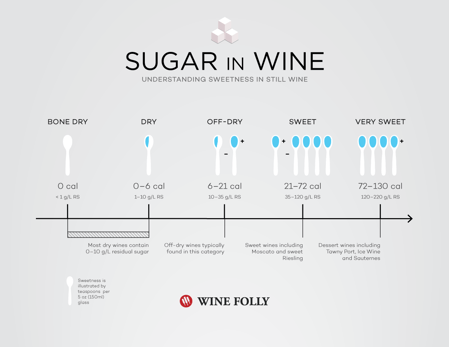How Much Sugar is in Your Wine?
This article discusses how much sugar, or more specifically, residual sugar, is in your wine.


With the popularity of low sugar, low carb, keto and paleo diets, you may be wondering how much sugar is in your wine.
Is there sugar in wine?
Some wines have no sugar, and others can have more than a can of soda! The sugar in wine is called residual sugar. Grapes contain the typical fruit sugars (fructose and glucose) and are combined with yeast during the winemaking process. Yeast consumes the fruit sugars and produces ethanol (alcohol) as a by-product. Residual sugar is the sugar in wine that remains after the grapes have gone through this process. If the yeast is allowed to consume most or all of the sugar, the result is a dry wine. Dry wines are typically higher in alcohol content and low in residual sugar. If a wine maker stops the yeast from consuming all the fruit sugars (often by rapid chilling), the result is a sweet wine that is typically lower in alcohol and higher in residual sugar.
Residual sugar is usually displayed as either: grams/Liter (g/L) or as a percentage. For example, 10 g/L of residual sugar is equal to 1% sweetness and results in 6 sugar calories and 1.5 tota carbs in a 5oz serving. Wines range from 0-220 g/L of sugar, depending on the style. Most countries (including the USA) aren’t required to label actual sweetness (sugar) levels in wine. Fortunately, most of the good wineries provide technical data sheets on their websites so you can do your own research to figure out how much residual sugar your favorite wine contains. One wine club that offers labeling of all their wines for sugar content is Dry Farm Wines. All of their wines are dry, with less than 1 gram of residual sugar per Liter (plus all their wines are organic, non-GMO and under 12.5% alcohol by volume). If you cannot find a tech sheet for your favorite wine, then a general rule is that cheaper wines (under $15) tend to contain more residual sugar. Wines that are slightly more expensive tend to feature less residual sugar as the grapes are typically of a higher quality so the wines don't need the extra sweetness to taste fruity. Of course, there are exceptions to this rule!
Here are some examples of popular dry white wines: Sauvignon Blanc, Pinot Grigio, Chardonnay
And popular dry red wines: Merlot, Malbec, Pinot Noir, Cabernet Sauvignon, Shiraz
To keep the amount of sugar in wine in perspective, even drinking a full bottle of your typical red wine would give you only 1/3 the amount of sugar in a single glass of soda. Keep in mind that alcohol contains more calories than sugar, so if you’re after something low calorie, choose a wine that’s dry and has lower alcohol too.
If you have questions regarding healthier wine, or there is a topic that you would like to see covered by Healthy Wine guy, please contact us at healthywineguy@gmail.com.
"wine that gladdens human hearts" (Psalm 104:15)
